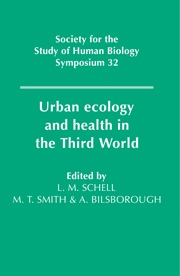Book contents
- Frontmatter
- Contents
- List of contributors
- Acknowledgements
- 1 Human biological approaches to the study of Third World urbanism
- 2 Social and cultural influences in the risk of cardiovascular disease in urban Brazil
- 3 The urban disadvantage in the developing world and the physical and mental growth of children
- 4 Differences in endocrine status associated with urban-rural patterns of growth and maturation in Bundi (Gende-speaking) adolescents of Papua New Guinea
- 5 Nutritionally vulnerable households in the urban slum economy: a case study from Khulna, Bangladesh
- 6 Urban-rural differences in growth and diarrhoeal morbidity of Filipino infants
- 7 Child health and growth in urban South Africa
- 8 From countryside to town in Morocco: ecology, culture and public health
- 9 Urban-rural population research: a town like Alice
- 10 Selection for rural-to-urban migrants in Guatemala
- 11 Health and nutrition in Mixtec Indians: factors influencing the decision to migrate to urban centres
- 12 Urban health and ecology in Bunia, N.E. Zaire, with special reference to the physical development of children
- 13 Food for thought: meeting a basic need for low-income urban residents
- 14 Immunological parameters in northeast Arnhem Land Aborigines: consequences of changing settlement patterns and lifestyles
- 15 Amerindians and the price of modernisation
- 16 Sex ratio determinants in Indian populations: studies at national, state and district levels
- 17 Polarisation and depolarisation in Africa
- 18 Urbanisation in the Third World: health policy implications
- Index
6 - Urban-rural differences in growth and diarrhoeal morbidity of Filipino infants
Published online by Cambridge University Press: 26 December 2009
- Frontmatter
- Contents
- List of contributors
- Acknowledgements
- 1 Human biological approaches to the study of Third World urbanism
- 2 Social and cultural influences in the risk of cardiovascular disease in urban Brazil
- 3 The urban disadvantage in the developing world and the physical and mental growth of children
- 4 Differences in endocrine status associated with urban-rural patterns of growth and maturation in Bundi (Gende-speaking) adolescents of Papua New Guinea
- 5 Nutritionally vulnerable households in the urban slum economy: a case study from Khulna, Bangladesh
- 6 Urban-rural differences in growth and diarrhoeal morbidity of Filipino infants
- 7 Child health and growth in urban South Africa
- 8 From countryside to town in Morocco: ecology, culture and public health
- 9 Urban-rural population research: a town like Alice
- 10 Selection for rural-to-urban migrants in Guatemala
- 11 Health and nutrition in Mixtec Indians: factors influencing the decision to migrate to urban centres
- 12 Urban health and ecology in Bunia, N.E. Zaire, with special reference to the physical development of children
- 13 Food for thought: meeting a basic need for low-income urban residents
- 14 Immunological parameters in northeast Arnhem Land Aborigines: consequences of changing settlement patterns and lifestyles
- 15 Amerindians and the price of modernisation
- 16 Sex ratio determinants in Indian populations: studies at national, state and district levels
- 17 Polarisation and depolarisation in Africa
- 18 Urbanisation in the Third World: health policy implications
- Index
Summary
Introduction
Numerous reports that present data on child growth and health outcomes around the world highlight urban-rural differences. Many of the classic growth studies reported in Tanner & Eveleth (1976) show that, in general, children in urban areas tend to be healthier, taller and heavier than children in surrounding rural areas. Similarly, data from the FAO's 1985 Fifth World Survey (presented in Fig. 1 of Keller, 1988) show consistent urban-rural differences in the prevalence of stunting and wasting among 0–5 year old children (see Fig. 6.1). The better health status of urban children is often attributed to a regular supply of goods, health and sanitation services, education, and medical facilities, associated with the urban environment.
If we look at large urban centres of the developing world over the past two decades, however, a different picture begins to emerge (Popkin & Bisgrove, 1988). Urban centres are not necessarily uniformly healthy environments. Population growth in urban centres is proceeding at a very rapid rate: by the year 2000, it is projected that 43% of people in developing countries will live in cities (United Nations, 1980). Concomitant with rapid population growth, due to both migration and natural increase, is a dramatic shift in demographic and socioeconomic composition of urban areas. Approximately one third of the world's poor now live in cities (Churchill, 1980), mostly in makeshift squatter settlements that share problems of poverty, overcrowding, poor environmental conditions and psychological stress.
- Type
- Chapter
- Information
- Urban Ecology and Health in the Third World , pp. 75 - 98Publisher: Cambridge University PressPrint publication year: 1993
- 9
- Cited by



